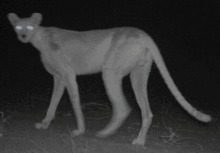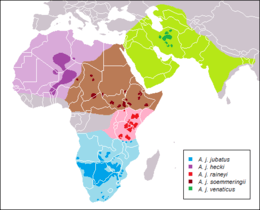Northwest African cheetah
| Northwest African cheetah | |
|---|---|
 | |
| A cheetah at Termit Massif, Niger | |
| Scientific classification | |
| Kingdom: | Animalia |
| Phylum: | Chordata |
| Class: | Mammalia |
| Order: | Carnivora |
| Suborder: | Feliformia |
| Family: | Felidae |
| Subfamily: | Felinae |
| Genus: | Acinonyx |
| Species: | A. jubatus |
| Subspecies: | A. j. hecki[2] |
| Trinomial name | |
| Acinonyx jubatus hecki[2] Hilzheimer, 1913 | |
 | |
| A. j. hecki range historical today | |
| Synonyms | |
|
Acinonyx jubatus senegalensis (Blainville, 1843) | |
The Northwest African cheetah (Acinonyx jubatus hecki), also known as the Saharan cheetah, is a cheetah subspecies native to the Sahara desert and the Sahel. It is listed as Critically Endangered on the IUCN Red List. In 2008, the population was suspected to number less than 250 mature individuals.[1]
The Northwest African cheetah was described by German zoologist Max Hilzheimer in 1913 under the scientific name Acinonyx hecki on the basis of a specimen from Senegal.[3]
Taxonomy
The Northwest African cheetah was described by Max Hilzheimer under the binomial name Acinonyx hecki in 1913, based upon a living specimen in the Berlin Zoological Garden that originated in Senegal. In 1843, the French zoologist Henri Marie Ducrotay de Blainville described a cheetah from Senegal as Felis jubata senegalensis.[3] As this name was preoccupied, it is considered synonymous with A. j. hecki.[4][2]
Characteristics
The Northwest African cheetah is quite different in appearance from the other African cheetahs. Its coat is shorter and nearly white in color, with spots that fade from black over the spine to light brown on the legs. The face has few or even no spots, and the tear stripes (dark stripes running from the medial canthus of each eye down the side of the muzzle to the corner of the mouth) are often missing. The body shape is basically the same as that of the sub-Saharan cheetah, except that it is somewhat smaller.[5]
Distribution and habitat
The Saharan cheetah ranges in the western and central Sahara desert and the Sahel in small, fragmented populations. Between August 2008 and November 2010, four individuals were recorded by camera traps in Ahaggar Cultural Park located in south central Algeria.[6] Based on data from 2007 to 2012, the cheetah population in West, Central and North Africa has been estimated at 457 individuals in an area of 1,037,322 km2 (400,512 sq mi), including 238 cheetahs in Central African Republic and Chad, 191 cheetahs in Algeria and Mali, and 25 cheetahs in the transboundary W, Arli, and Pendjari protected area complex in Benin, Burkina Faso and Niger.[7] In Niger, populations occur in the northern parts of the country in the Ténéré desert and in the southern savanna region of W National Park. Records in Togo date to the 1970s. The Saharan cheetah is thought to be regionally extinct in Morocco, Western Sahara, Senegal, Guinea, Guinea-Bissau, Sierra Leone, Côte d'Ivoire and Ghana.[1]
In Mali, cheetahs were sighted in Adrar des Ifoghas and in the Kidal Region in the 1990s.[8] In 2010, a cheetah was photographed in Niger's Termit Massif by a camera trap.[9]
No cheetah was recorded in the North Province, Cameroon during a survey carried out between January 2008 and May 2010.[10]
Ecology and behavior
The cheetah exhibits important physiological and behavioral adaptations that allow it to survive in the extreme conditions of the Sahara desert, where temperatures reach up to 45 °C (113 °F), and where there is no standing water. For example, the Northwest African cheetah is even more nocturnal than other cheetahs, which helps it to conserve water and stay out of the daytime heat of the desert.
The cheetah is usually solitary and semi-nomadic. Small groups do occur though, usually as mother and cubs or male coalitions, which usually have only a very small range. Female territories are located in areas of high prey base, which therefore determine male territories.
Hunting and diet
The main prey of the Northwest African cheetah are antelopes which have adapted to an arid environment, such as the addax, Dorcas gazelle, rhim gazelle, and dama gazelle. It also preys on smaller mammals such as hares. Cheetahs can subsist without direct access to water, obtaining water indirectly from the blood of their prey.[11]
See also
References
- 1 2 3 Belbachir, F. (2008). "Acinonyx jubatus ssp. hecki". IUCN Red List of Threatened Species. Version 2017-2. International Union for Conservation of Nature.
- 1 2 3 Wozencraft, W.C. (2005). "Order Carnivora". In Wilson, D.E.; Reeder, D.M. Mammal Species of the World: A Taxonomic and Geographic Reference (3rd ed.). Johns Hopkins University Press. p. 533. ISBN 978-0-8018-8221-0. OCLC 62265494.
- 1 2 Allen, G. M. (1939). "Acinonyx Brookes. Cheetahs". A Checklist of African Mammals. Cambridge: Bulletin of the Museum of Comparative Zoology at Harvard College 83. pp. 232–234.
- ↑ Rosevear, D.R. (1974). "Acinonyx jubatus (Schreber)". The carnivores of West Africa. London: Natural History Museum. pp. 493–511.
- ↑ "All Those Spotted Cats Look Alike". Retrieved 2010-12-25.
- ↑ Belbachir, F.; Pettorelli, N.; Wacher, T.; Belbachir-Bazi, A.; Durant, S.M. (2015). "Monitoring rarity: the critically endangered Saharan cheetah as a flagship species for a threatened ecosystem". PLoS One. 10 (1): e0115136. doi:10.1371/journal.pone.0115136. PMC 4309643. PMID 25629400.
- ↑ Durant, S.M., Mitchell, N., Groom, R., Pettorelli, N., Ipavec, A., Jacobson, A.P., Woodroffe, R., Böhm, M., Hunter, L.T., Becker, M.S. and Broekhuis, F., Bashir, S., Andresen, L., Aschenborn, O., Beddiaf, M., Belbachir, F.; et al. (2017). "The global decline of cheetah Acinonyx jubatus and what it means for conservation". Proceedings of the National Academy of Sciences. 114 (3): 528−533. doi:10.1073/pnas.1611122114.
- ↑ Drieux-Dumont, A.-M. (2002). "Etude préliminaire du statut du guépard du Sahara (Acinonyx jubatus), Adrar des Iforas, Mali". In Chapron, G.; Moutou, F. L'Etude et la conservation des carnivores. Paris, France: Société Française pour l'Etude et la Protection des Mammifères.
- ↑ Walker, M. (2010). 'Ghostly' Saharan cheetah filmed in Niger, Africa. BBC Earth News, 23 December 2010.
- ↑ de Iongh, H.H., Croes, B., Rasmussen, G., Buij, R. and Funston, P. (2011). "The status of cheetah and African wild dog in the Benoue Ecosystem, North Cameroon" (PDF). Cat News. 55: 29−31.
- ↑ Hayward, M.W.; Hofmeyr, M.; O'Brien, J.; Kerley, G.I.H. (2006). "Prey preferences of the cheetah (Acinonyx jubatus) (Felidae: Carnivora): morphological limitations or the need to capture rapidly consumable prey before kleptoparasites arrive?". Journal of Zoology. 270 (4): 615–27. doi:10.1111/j.1469-7998.2006.00184.x.
External links
| Wikispecies has information related to Acinonyx jubatus hecki |
| Wikimedia Commons has media related to Acinonyx jubatus hecki. |
